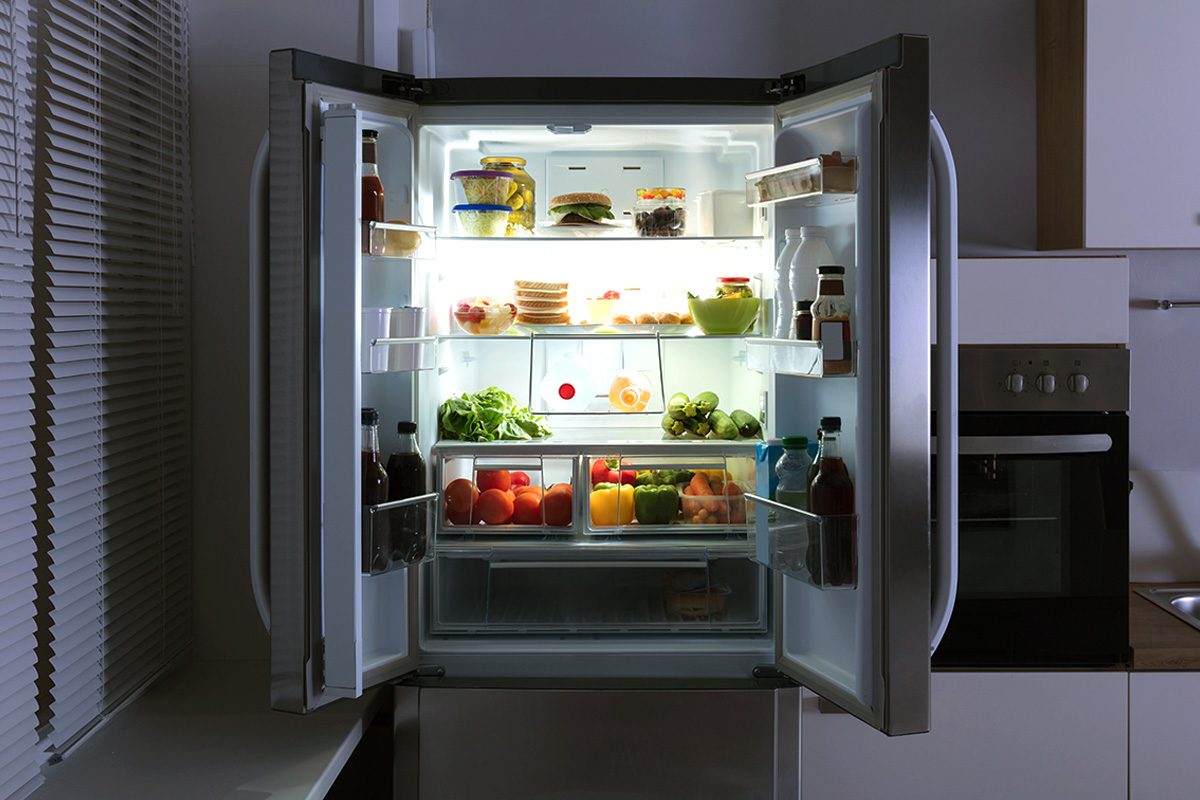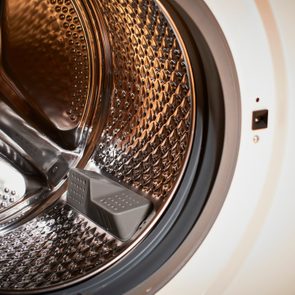You really don't want to know what is lurking there ... but you absolutely should

This Part of Your Refrigerator Is Probably Overdue for a Deep Clean

If you’re like me, you’re germ-aware—or is it germ-obsessed?—and super careful about cleaning your kitchen right. You’d never prep raw chicken without thoroughly sanitizing the nearby counters or slop steak juice on the floor without wiping it right up.
But chances are, you’re overlooking (and undercleaning) one key spot. It’s a zone you use constantly but hardly ever think about de-griming. When I stumbled upon a study that called out this surface as one of the germiest places in the kitchen, I wanted to know more. So I reached out to three public-health experts to find out what might be lurking there.
Here’s what I learned about the most unexpectedly germy place in your kitchen—and how to clean it properly so you don’t end up sick.
Get Reader’s Digest’s Read Up newsletter for more cleaning, travel, tech, humor and fun facts all week long.
What part of your kitchen is often overlooked when cleaning?
Surprise: It’s the refrigerator handle. “It’s germier than we think, because we open the refrigerator multiple times while handling foods that contain microbes,” says Jill Roberts, PhD, MPH, associate professor of public health at the University of South Florida in Tampa, Florida.
And scientists have swabbed kitchens to confirm this (unfun) fact. A 2022 study published in Frontiers in Microbiology found the fridge handle is so full of bacteria, it’s the second-biggest source of foodborne pathogens in the kitchen, behind only the sink.
What kinds of germs can accumulate here?
You’ll find all kinds of microbes on a fridge handle, but there are a few Roberts considers “truly dangerous.” Fridge handles can contain E. coli, a dangerous form of bacteria that often sneaks in your kitchen via raw beef. Ingesting E. coli can cause everything from diarrhea and vomiting to kidney failure, Roberts says.
Fridge handles may also harbor salmonella, campylobacter and listeria, thanks to raw chicken. “These pathogens can cause diseases ranging from mild foodborne illnesses to life-threatening infections,” Roberts says.
Remember the aforementioned study that found fridge handles to be the second-germiest kitchen surface? The handles examined by the researchers were crawling with E. coli, klebsiella pneumoniae and Staphylococcus aureus pathogens.
Now for some good news: There are also friendly bugs on your fridge handle. They’re part of your home’s “rich and diverse microbiome,” says Karen C. Dannemiller, PhD, an associate professor at the Ohio State University who directs the Indoor Environmental Quality Research Group. “There can be hundreds to thousands of species of bacteria, fungi and viruses in a kitchen, but most of them aren’t harmful.”
How do germs end up on fridge handles?

The most common way the fridge grip gets germy is through food prep. One big mistake we all make is “handling raw meat and then touching the refrigerator handles,” Roberts says. Then we transfer germs to our nose and mouth.
But some of what ends up on the fridge was on our hands all along. “Most of the microbes that are on your refrigerator door handle are probably from human skin, just like door knobs and light switches and other high-touch surfaces,” Dannemiller says. “We have natural microbes all over our body, and when you touch the surface, some of the bacteria and fungi from your hand will be left there.”
Kitchen handles and knobs also get gunky from everyday family life. (Kids, messy? Who knew!) Germs on the fridge handle can come from our exhaled breath, outdoor air, tracked-in soil and even our pets. Your slobbery dog licks your child’s hands. Said kiddo opens the fridge to grab a snack and transfers from their hand to the handle whatever your pooch last licked. Rabbit poop? A poodle butt? Don’t even think about it. Seriously.
Why is this such a problem?
If pathogens hitch a ride from a germy surface onto your hands, you could get sick. “The circle of infection is handle to hands, hands to food, food to mouth,” Roberts explains. By opening the fridge, your hand gets contaminated from whatever’s on the grip. If you then pop a few grapes or munch on a cracker, you’ll transfer any germs you picked up straight into your gullet.
Some microbes are no big deal, Dannemiller stresses. Others, alas, cause respiratory illnesses and gastrointestinal infections. Pathogens can come from someone who has the common cold wiping their nose or not washing their hands properly (or at all, ew) after using the bathroom and then touching a surface. “On a surface such as a refrigerator door handle,” she adds, “they could also come from someone who didn’t wash their hands well enough while preparing raw food.”
As you probably know, salmonella, listeria and E. coli infections can make you really sick. Foodborne illnesses cause around 128,000 hospitalizations and 3,000 deaths a year, according to the FDA.
How often should you clean the fridge door handle?
Before we answer that question, you should know how long germs can survive on surfaces. Salmonella can last for up to 32 hours on surfaces, according to the USDA. A flu virus can survive for 24 hours or longer on a nonporous surface (like a plastic handle), according to the CDC. And those are just two examples. Put simply, you don’t want to wait for a weekly cleaning to wipe away these bugs.
While there’s no hard-and-fast rule for how often to clean this handle, the experts I talked to recommend swiping these surfaces with a disinfecting wipe or spray every time you’re handling food. Yes, you read that right—every time. They’re even talking about handling produce, which is a stealthy source of foodborne illness.
We should also mention that this applies to freezer door handles as well, so don’t forget that one in your cleaning efforts!
What’s the best way to clean a fridge handle?
For quickie cleanups, use a disinfectant wipe that kills microbes (such as Lysol or Clorox wipes) to sanitize your fridge and freezer handles. But you’ll also want to get in there and scrub them regularly. “Microbes can survive if there is a lot of organic matter present—in other words, fluids from foods and food particles,” Roberts says.
Whatever you do, don’t wipe the surface with one of your kitchen sponges. “Sponges are one of the most contaminated locations in the home,” notes Paul L. Dawson, PhD, a professor of food, nutrition and packaging sciences at Clemson University. In 2024, he published a study on microbes in college students’ apartment kitchens and found that after two weeks of use, “the kitchen sponges contained around 8 million bacteria.”
Are there any other ways to avoid picking up a bug from your fridge handle?
Yes, break out the hand soap and scrub-a-dub-dub. “Handwashing is absolutely critical,” Roberts says. “There are three major causes of foodborne illness, and one is poor personal hygiene. Almost all cases of norovirus, the leading cause of foodborne illness, can be prevented by simple handwashing.” Good to know!
RELATED:
- This Bedroom Item Is Surprisingly Dirty—Here Are the Gross Things That Happen If You Don’t Clean It
- This Is the Dirtiest Part of a Cruise Ship, According to the CDC
- The Surprising Reason You Should Never Rest Your Head Against an Airplane Window
About the experts
|
Why trust us
At Reader’s Digest, we’re committed to producing high-quality content by writers with expertise and experience in their field in consultation with relevant, qualified experts. We rely on reputable primary sources, including government and professional organizations and academic institutions as well as our writers’ personal experiences where appropriate. We verify all facts and data, back them with credible sourcing and revisit them over time to ensure they remain accurate and up to date. Read more about our team, our contributors and our editorial policies.
Sources:
- Jill Roberts, PhD, MPH, associate professor in the College of Public Health’s department of global, environmental and genomic health sciences at the University of South Florida; email interview, July 23, 2025
- Karen Dannemiller, PhD, associate professor at the Ohio State University and director of the Indoor Environmental Quality Research Group; email interview, July 24, 2025
- Paul L. Dawson, PhD, professor of food, nutrition and packaging sciences at Clemson University; email interview, July 24, 2025
- Frontiers in Microbiology: “Evaluation of the kitchen microbiome and food safety behaviors of predominantly low-income families”
- USDA: “Study Shows Most People Are Spreading Dangerous Bacteria Around the Kitchen and Don’t Even Realize It”
- FDA: “Safe Food Handling”
- Clemson Cooperative Extension Home & Garden Information Center: “Kitchen Hygiene: Let’s Talk About That Sponge”
- USDA: “Washing Food: Does It Promote Food Safety?”
- Journal of Food Research: “Recovery of Microorganisms from Various Locations in Apartments Occupied by College Students”























